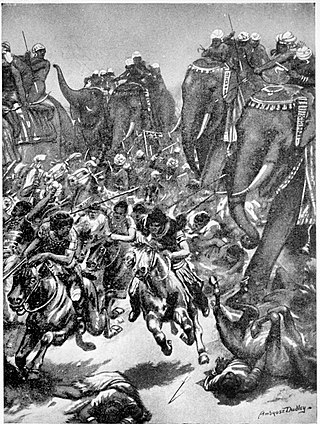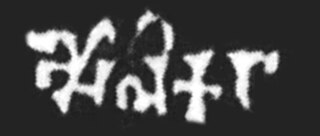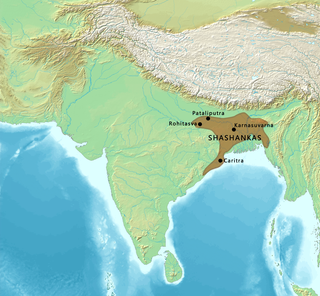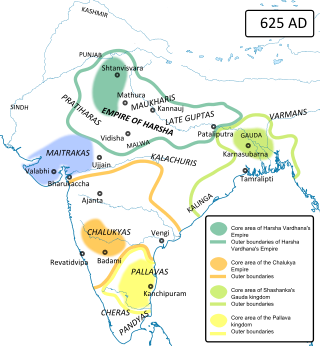Related Research Articles
The Gupta Empire was an ancient Indian empire which existed from the early 4th century CE to early 6th century CE. At its zenith, from approximately 319 to 467 CE, it covered much of the Indian subcontinent. This period has been considered as the Golden Age of India by some historians, although this characterisation has been disputed by other historians. The ruling dynasty of the empire was founded by Gupta, and the most notable rulers of the dynasty were Chandragupta I, Samudragupta, Chandragupta II and Skandagupta. The 5th-century CE Sanskrit poet Kalidasa credits the Guptas with having conquered about twenty-one kingdoms, both in and outside India, including the kingdoms of Parasikas, the Hunas, the Kambojas, tribes located in the west and east Oxus valleys, the Kinnaras, Kiratas, and others.

Chandragupta I was a king of the Gupta Empire, who ruled in northern and central India. His title Maharajadhiraja suggests that he was the first emperor of the dynasty. It is not certain how he turned his small ancestral kingdom into an empire, although a widely accepted theory among modern historians is that his marriage to the Licchavi princess Kumaradevi helped him extend his political power. Their son Samudragupta further expanded the Gupta empire.

Magadha also called the Kingdom of Magadha or the Magadha Empire, was a kingdom and empire, and one of the sixteen Mahajanapadas, 'Great Kingdoms' of the Second Urbanization, based in southern Bihar in the eastern Ganges Plain, in Ancient India. Magadha was ruled by the Brihadratha dynasty, the Haryanka dynasty, the Shaishunaga dynasty, the Nanda dynasty, the Mauryan dynasty, the Shunga dynasty and the Kanva dynasty. It lost much of it territories after being defeated by the Satavahanas of Deccan in 28 BC and was reduced to a small principality around Pataliputra. Under the Mauryas, Magadha became a pan-Indian empire, covering large swaths of the Indian subcontinent and Afghanistan.

Mandsaur is a city and a municipality in Mandsaur district located on the border of Mewar and Malwa regions of Madhya Pradesh, a state in Central India. It is the administrative headquarters of Mandsaur District. The ancient Pashupatinath Temple is located in Mandsaur.

The Kanva dynasty or Kanvayana was the eighth ruling dynasty of Magadha, established after Vasudeva Kanva overthrew the preceding Shunga dynasty and ruled from 73 BCE to 28 BCE.

Kosala, sometimes referred as "Uttara Kosala" transl. "Northern Kosala") was one of the sixteen great realms of ancient India. It emerged as a small state during the Late Vedic period and became one of the earliest states to transition from a lineage-based society to a monarchy. By the 6th century BCE, it had consolidated into one of the four great powers of ancient northern India, along with Magadha, Vatsa, and Avanti.

Yashodharman was a ruler of Malwa, in Central India, during the early part of the 6th century. He probably belonged to the Second Aulikara dynasty. He conquered much of the Indian subcontinent between c. 530-540 AD according to Mandsaur pillar inscription.

Shashanka was the first independent king of a unified polity in the Bengal region, called the Gauda Kingdom and is a major figure in Bengali history. He reigned in the 7th century, some historians place his rule between circa 600 CE and 636/7 CE, whereas other sources place his reign between 590 and 625 CE.

The history of Bihar is one of the most varied in India.Chirand, on the northern bank of the Ganga River, in Saran district, has an archaeological record dating from the Neolithic age. Regions of Bihar—such as Magadha, Mithila and Anga—are mentioned in religious texts and epics of ancient India. Mithila is believed to be the centre of Indian power in the Later Vedic period. Mithila first gained prominence after the establishment of the ancient Videha Kingdom. The kings of the Videha were called Janakas. A daughter of one of the Janaks of Mithila, Sita, is mentioned as consort of Lord Rama in the Hindu epic Ramayana. The kingdom later became incorporated into the Vajjika League which had its capital in the city of Vaishali, which is also in Mithila.

Avanti was an ancient Indian Mahajanapada, roughly corresponding to the present-day Malwa region. According to the Buddhist texts, the Anguttara Nikaya, Avanti was one of the solasa mahajanapadas of the 6th century BCE. The janapada was divided into two parts by the Vindhyas, the northern part had its capital at Ujjayini and the southern part had its centre at Mahishmati.

Pradyota dynasty, also called Prthivim Bhoksyanti, was a ruling dynasty of Avanti, founded by Pradyota, after his father Punika, a minister in the court of the king of Ujjaini, the northern part of the former Avanti kingdom, and placed his own son on the throne in 546 BCE.
There are conflicting theories regarding the original homeland and ancestry of the Gupta dynasty that ruled northern India between 4th and 6th centuries. Modern historians variously theorize that it originated in present-day Uttar Pradesh or Bengal, based on epigraphic, numismatic and literary evidence. The social group (varna) of the dynasty is also a matter of debate, with scholars variously placing them in kshatriya Vaishya, Brahmana, or other categories.

The Aulikaras, also referred to as Aulikara dynasty or Olikara dynasty, were an ancient Indian clan from the Maurya era, that emerged into a kingdom between the 4th-century CE and 6th-century CE. They were based in the Malwa (Malawa) region of central India near Mandsaur, with their power center near what is now western Madhya Pradesh, southeastern Rajasthan and northeastern Gujarat. Two royal houses belonging to this clan ruled over the present-day western Malwa region of Madhya Pradesh state from c. 350 CE to 550 CE, much of it as feudatories of the Gupta Empire.
Jettha Tissa I also referred to as Dethutis, Kalakandetu Tissa, and Makalan Detu Tissa, was the eldest son of Gothabhaya and brother of Mahasena. He was a king of Sri Lanka for ten years.

The Gauḍa Kingdom or Shashankas, was a classic kingdom during the Classical period on the Indian subcontinent, which originated in the Gauda region of Bengal in 4th century CE or possibly earlier.
Prabhakaravardhana was a king of Thanesar in northern India around the time of the decline of the Gupta Empire. According to the historian R. C. Majumdar, he was the first notable king of the Vardhana dynasty but the fourth ruler from the family, who are also referred to as the Pushpabhutis. He had been preceded by his father, Adityavardhana, grandfather Rajyavardhana I and great-grandfather, Naravardhana, but inscriptions suggest that Banabhatta, the seventh-century bard and chronicler of the Vardhanas, may have been wrong to call these earlier rulers kings and that they may instead have been mere feudatory rulers of minor significance.

The Later Gupta dynasty ruled Magadha in eastern India between the 6th and 8th centuries CE. The Later Guptas succeeded the Imperial Guptas as the rulers of eastern Malwa or Magadha, but there is no evidence connecting the two dynasties; these appear to be two distinct families. The "Later Guptas" are so-called because the names of their rulers ended with the suffix "-gupta", which they might have adopted to portray themselves as the successors of the Imperial Guptas.
Govindagupta was a Gupta prince of ancient India. He was a son of Chandragupta II and Dhruvadevi, and a brother of Kumaragupta.
The Second Aulikara dynasty was a royal dynasty that ruled over the Malwa plateau, and at its peak under Yashodharman Vishnuvardhana controlled a vast area, consisting of almost all of Northern India and parts of Deccan plateau. It was the second royal house of the Aulikara clan.

The Battle of Sondani was a large military encounter fought in 528 CE, between the Alchon Hun emperor Mihirakula and a confederation of Indian rulers led by king Yashodharman of Malwa.